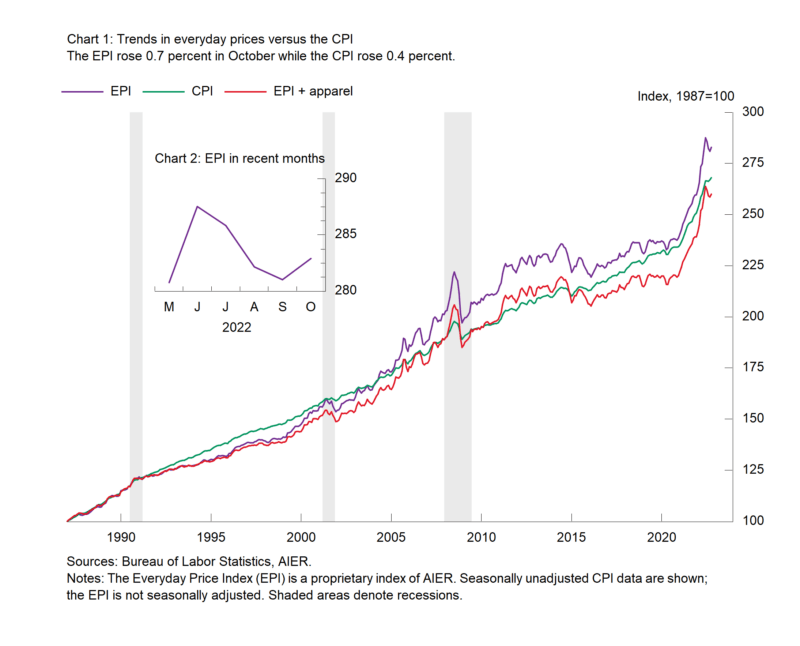AIER’s Everyday Price Index Rises After Three Consecutive Declines
AIER’s Everyday Price rose 0.7 percent in October following declines of 0.4 percent in September, 1.3 percent in August, and 0.6 percent in July. Those were the first run of three consecutive declines since the period from February through April 2020. From a year ago, the Everyday Price Index is up 9.5 percent. Motor fuel, food at home, and food away from home accounted for most of the rise in October, while home fuels and utilities had the largest negative contribution.
Motor fuel prices, which are often a significant driver of the monthly changes in the Everyday Price index because of the large weighting in the index and the volatility of the underlying commodity, jumped 3.1 percent for the month, adding 39 basis points (on a not-seasonally adjusted basis). Prices for food away from home (primarily restaurants) rose by 0.9 percent, while food at home (groceries) increased by 0.5 percent. Both components added 14 basis points each for the month. Other smaller positive contributions came from alcoholic beverages (0.2 basis points), housekeeping supplies (0.2 basis points), cable, satellite and radio service (0.2 basis points), and pets and pet products (0.2 basis points).
Household fuels and utilities prices fell 0.9 percent, reducing the overall increase by 13 basis points. Intracity transportation, prescription drugs, recreational reading materials, and telephone services also had decreases for the month. A total of 5 categories had price decreases versus 18 showing increases.
The Everyday Price Index, including apparel, a broader measure that includes clothing and shoes, rose 0.6 percent in October following three consecutive declines. Over the past year, the Everyday Price Index, including apparel, is up 9.1 percent, the lowest since January.
Apparel prices fell 0.6 percent on a not-seasonally-adjusted basis in October. Apparel prices tend to be volatile on a month-to-month basis. From a year ago, apparel prices are up 4.1 percent.
The Consumer Price Index, which includes everyday purchases and infrequently purchased, big-ticket items and contractually fixed items, rose 0.4 percent on a not-seasonally-adjusted basis in October. Within the CPI, energy posted a 1.0 percent rise on a not-seasonally-adjusted basis while food had a 0.7 percent increase. Over the past year, the Consumer Price Index is up 7.7 percent.
The Consumer Price Index, excluding food and energy, rose 0.3 percent for the month (not seasonally adjusted) while the 12-month change came in at 6.3 percent. The 12-month change in the core CPI was just 1.3 percent in February 2021 and 2.3 percent in January 2020, before the pandemic.
After seasonal adjustment, the CPI rose 0.4 percent in October while the core increased 0.3 percent for the month. Within the core, core goods prices fell 0.4 percent in October and were up 5.1 percent from a year ago. New vehicles prices were a significant contributor, rising 0.4 percent for the month. On the downside, the index for used cars and trucks fell 2.4 percent, technology products fell 1.0 percent, the index for other recreational goods decreased 0.9 percent, and household furnishings and supplies prices fell 0.2 percent.
Core services prices were up 0.5 percent for the month and 6.7 percent from a year ago. Among core services, gainers include shelter, which accounts for 32.6 percent of the CPI, up 0.8 percent for the month. The shelter index increased 6.9 percent over the last year, accounting for over 40 percent of the total increase in all items less food and energy.
Other core services components that rose in October were the index for motor vehicle insurance (up 1.7 percent), and recreation (up 0.7 percent). On the downside, index for airline fares fell 1.1 percent in October, the medical care index fell 0.5 percent, the index for hospital and related services decreased 0.2 percent, and the index for prescription drugs declined 0.1 percent.
Price pressures for many goods and services in the economy remain elevated. Sustained elevated price increases are likely distorting economic activity by influencing consumer and business decisions. Furthermore, price pressures have resulted in an aggressive Fed tightening cycle, raising the risk of a policy mistake. The fallout surrounding the Russian invasion of Ukraine continues to disrupt global supply chains while labor shortages and turnover continue to challenge businesses. All of these are sustaining a high level of uncertainty for the economic outlook. Caution is warranted.







